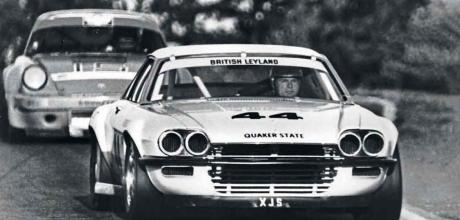Jaguar XJ-S’ first race, Mosport Park, August 1976
As our feature on shows, the XJ-S could be turned into more of a sports car, although it wasn’t a natural racing car due to its size and weight. That didn’t stop Bob Tullius and his Group 44 team from campaigning the car in the late Seventies, with considerable success.
Finishing lines
For Tullius, the car represented a natural progression: from 1974, and with backing from Jaguar North America, he had successfully raced the E-type Series 3, winning the 1975 Sports Car Club of America National B Production Championship, but, by the time he had won the final race in November, the car had been superseded by the XJ-S.
The XJ-S was a different car altogether and sales were initially slow. To gain publicity, Jaguar North America sales vice president, Michael Dale, offered Tullius an XJ-S for the 1976 season; in February, a white example – chassis number 2W51120 – entered Group 44’s workshop in Herdon, Virginia, ready for conversion into the world’s first racing XJ-S.
Tullius’ business partner and Group 44’s chief mechanic, Brian Fuerstenau, felt Jaguar’s V12 was adequate for racing, so the engine was kept relatively standard, although he did oversee the addition of six double-choke Weber 44 IDF carburettors and a Mangoletsi manifold, made in the UK for Ron Beaty’s Forward Engineering. More importantly, the car was modified to dry sump lubrication.
The changes resulted in 475bhp at 7,600rpm. Road & Track magazine recorded a 0-100mph time of 10.3 seconds during a track test with Tullius. While the suspension and steering were adaptations from the road car, larger brake discs with eight-piston calipers were installed at the front. Huge, 10in magnesium alloys, shod with fat tyres, necessitated flared wheelarches and, of course, it needed a roll cage fitting. However, there were few, if any, aerodynamic changes. “Probably the most surprising thing about the XJ-S is its aerodynamics,” said Tullius in a 1976 magazine interview. “According to the sales brochure, Jaguar did a lot of wind tunnel testing of the body design, but I figured half of that was BS and the other half was somebody dreaming. Well, let me tell you, I’m a believer. To see if Jaguar’s claims were anywhere near right, we decided to keep this prototype XJ-S aerodynamically stock. You’ll notice that we even use the production front spoiler.”
However, the car was not ready for the start of the 1976 season, so Tullius initially continued with the E-type, winning three races. The XJ-S was finally presented in July 1976, at Watkins Glen (the race, coincidently, included a BMW CLS driven by a certain Tom Walkinshaw, who would become a central figure in XJ-S racing a few years later), but, after practice – which showed the car was fast – Tullius withdrew, blaming poor weather conditions.
It wasn’t until 22 August 1976, at Mosport Park, Canada, that the car made its competition debut. It immediately showed its promise. Tullius qualified in pole and claimed the fastest lap in Category 1, which he led until the oil temperature started to soar and he had to back off. He eventually finished fourth in category and tenth overall. The encouraging start was reinforced when Tullius won the SCCA meeting at Lime Rock, Connecticut, soon afterwards.
Tullius went on to win the Trans-Am Championship in 1978 and 1979 with the car, proving that, while the XJ-S might not have been a natural racing car, it had the qualities to be transformed into a very good one.



In fine health
Thank you for the recent Finishing Lines article on the fabulous Group 44 XJ-S.
I am pleased to say that XJR2, the first of the three Group 44 XJ-Ss, is still in fine health in my lock-up. I am hoping to be able to wheel her out for some events next year and that may even include some races. It is a magnificent car and anyone with any Jaguar in their blood should try to watch it live.
Keep up the good work. I still eagerly await every edition.